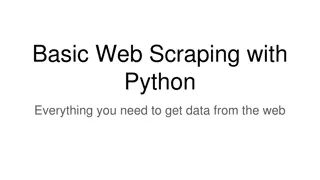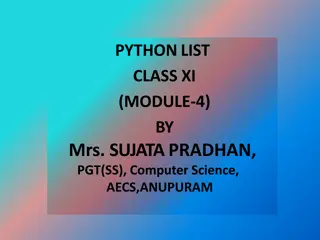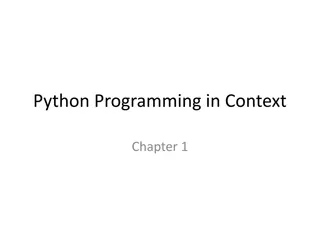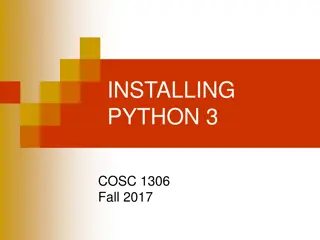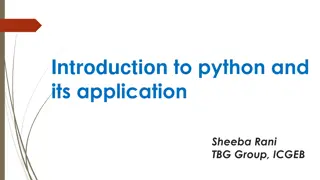Introduction to Decision Structures in Python
This lecture covers decision structures in Python, including one-way, two-way, and multi-way structures using if, if-else, and if-elif-else statements. It also reviews control structures, conditional operators, and implementing algorithms using decision structures. Learn about conditional operators, control flow, and the use of flowcharts to enhance your programming skills.
Download Presentation

Please find below an Image/Link to download the presentation.
The content on the website is provided AS IS for your information and personal use only. It may not be sold, licensed, or shared on other websites without obtaining consent from the author.If you encounter any issues during the download, it is possible that the publisher has removed the file from their server.
You are allowed to download the files provided on this website for personal or commercial use, subject to the condition that they are used lawfully. All files are the property of their respective owners.
The content on the website is provided AS IS for your information and personal use only. It may not be sold, licensed, or shared on other websites without obtaining consent from the author.
E N D
Presentation Transcript
CMSC201 Computer Science I for Majors Lecture 06 Decision Structures Prof. Katherine Gibson Prof. Jeremy Dixon www.umbc.edu Based on concepts from: https://blog.udemy.com/python-if-else/
Last Class We Covered Just a bit about main() More of Python s operators Comparison operators Logical operators LOTS of practice using these operators Reinforced order of operations Boolean variables 2 www.umbc.edu
Any Questions from Last Time? www.umbc.edu
Todays Objectives Understand decision structures One-way, two-way, and multi-way Using the if, if-else, and if-elif-else statements Review control structures & conditional operators More practice using the Boolean data type Learn how to implement algorithms using decision structures 4 www.umbc.edu
Simple Decisions So far, we ve only seen programs with sequences of instructions This is a fundamental programming concept But it s not enough to solve every problem We need to be able to control the flow of a program to suit particular situations What can we use to do that? 5 www.umbc.edu
Conditional Operators (Review) Python Mathematics Meaning < < <= == = >= > > != Less than Less than or equal to Equal to Greater than or equal to Greater than Not equal to 6 www.umbc.edu
Conditional Operators (Review) Python Mathematics Meaning < < <= == = >= > > != Less than Less than or equal to Equal to Greater than or equal to Greater than Not equal to 7 www.umbc.edu
Control Structures (Review) A program can proceed: In sequence Selectively (branching): make a choice Repetitively (iteratively): looping By calling a function focus of today s lecture 8 www.umbc.edu
Control Structures: Flowcharts focus of today s lecture 9 www.umbc.edu
One-Way Selection Structures www.umbc.edu
One-Way Selection Structures Selection statements allow a computer to make choices Based on some condition def main(): weight = float(input("How many pounds is your suitcase? ")) if weight > 50: print("There is a $25 charge for luggage that heavy.") print("Thank you for your business.") main() 11 www.umbc.edu
Temperature Example Convert from Celsius to Fahrenheit def main(): celsius = float(input("What is the Celsius temperature? ")) fahrenheit = 9/5 * celsius + 32 print("The temperature is", fahrenheit, "degrees Fahrenheit.") main() 12 www.umbc.edu
Temperature Example - Modified Let s say we want to modify the program to print a warning when the weather is extreme Any temperature that is Over 90 degrees Fahrenheit Will cause a hot weather warning Lower than 30 degrees Fahrenheit Will cause a cold weather warning 13 www.umbc.edu
Temperature Example - Modified Input: The temperature in degrees Celsius (call it celsius) Process: Calculate fahrenheit as 9/5 * celsius + 32 Output: Temperature in Fahrenheit If fahrenheit > 90 Display a heat warning If fahrenheit < 30 Display a cold warning 14 www.umbc.edu
Temperature Example - Modified This new algorithm has two decisions at the end The indentation after the if is important It means that a step should be performed only if the condition in the previous line is True 15 www.umbc.edu
Temperature Example Flowchart TRUE Print a heat warning fahrenheit > 90 Start FALSE Input: celsius temperature TRUE Print a cold warning fahrenheit < 30 fahrenheit = 9/5 * celsius + 32 FALSE Print: fahrenheit End 16 www.umbc.edu
Temperature Example Code def main(): celsius = float(input("What is the Celsius temp? ")) fahrenheit = 9 / 5 * celsius + 32 print("The temperature is", fahrenheit, "degrees fahrenheit.") if fahrenheit > 90: print("It's really hot out there, be careful!") if fahrenheit < 30: print("Brrrrr. Be sure to dress warmly!") main() 17 www.umbc.edu
Temperature Example Code def main(): celsius = float(input("What is the Celsius temp? ")) fahrenheit = 9 / 5 * celsius + 32 print("The temperature is", fahrenheit, "degrees fahrenheit.") if fahrenheit > 90: print("It's really hot out there, be careful!") if fahrenheit < 30: print("Brrrrr. Be sure to dress warmly!") this is the main level of our program this level of the code is only executed if fahrenheit > 90 this level of the code is only executed if fahrenheit < 30 main() 18 www.umbc.edu
if Statements www.umbc.edu
if Statements The Python if statement is used to implement the decision if <condition>: <body> The body is a sequence of one or more statements indented under the if heading 20 www.umbc.edu
if Semantics The semantics of the if should be clear First, the condition in the heading is evaluated If the condition is True The statements in the body are executed Control passes to the next statement in the program If the condition is False The statements in the body are skipped Control passes to the next statement in the program 21 www.umbc.edu
One-Way Decisions The body of the if either executes or not depending on the condition Control then passes to the next (non-body) statement after the if This is a one-way or simple decision 22 www.umbc.edu
What is a Condition? Conditions Can use any comparison (rational) operators Can use any logical (Boolean) operators Evaluate to True or False 23 www.umbc.edu
Two-Way Selection Structures www.umbc.edu
Two-Way Decisions In Python, a two-way decision can be implemented by attaching an else clause onto an if clause This is called an if-else statement: if <condition>: <statements> else: <statements> 25 www.umbc.edu
How Python Handles if-else When Python sees this structure, it evaluates the condition If the condition is True, the set of statements under the if are executed If the condition is False, the set of statements under the else are executed The code after the if-else is only executed after one of the sets of statements is executed 26 www.umbc.edu
Two-Way Code Framework if theCondition == True: <code1> else: <code2> Only execute code1 if theCondition is True If theCondition is not True, run code2 27 www.umbc.edu
Formatting Selection Structures Each if-else statement must close with a colon (:) Code in the body (that is executed as part of the if-else statement) must be indented By four spaces Hitting the Tab key in many editors (including emacs) will automatically indent it by four spaces 28 www.umbc.edu
Simple Two-Way Example def main(): x = 5 if x > 5: print("X is larger than five!") else: print("X is less than or equal to five!") main() this is the main level of our program this level of the code is only executed if x > 5 is True this level of the code is only executed if x > 5 is False 29 www.umbc.edu
Simple Two-Way Example #2 def main(): num = int(input("Enter a number: ")) if num % 2 == 0: print("Your number is even.") else: print("Your number is odd.") main() What does this code do? It checks whether a number is even or odd. 30 www.umbc.edu
Example Dangerous Dinosaurs You have just been flown to an island where there are a wide variety of dinosaurs You are unsure which are dangerous so we have come up with some rules to figure out which are dangerous and which are not 31 www.umbc.edu
Time for LIVECODING!!! 32 www.umbc.edu
Dinosaurs Example Sample rules: If the dinosaur has sharp teeth, it is dangerous If the dinosaur is behind a large wall, it is not dangerous If the dinosaur is walking on two legs, it is dangerous If the dinosaur has sharp claws and a beak, it is dangerous 33 www.umbc.edu
Dinosaurs Example - Variables What are some reasonable variables for this code? isSharp for isWalled for isBiped for isClawed for isBeaked for sharp teeth behind large wall walking on two legs sharp claws has beak 34 www.umbc.edu
Dinosaurs Example - Code def main(): print("Welcome to DinoCheck 1.0") print("Please answer 'True' or 'False' for each question") isSharp = input("Does the dinosaur have sharp teeth? ") isWalled = input("Is the dinosaur behind a large wall? ") isBiped = input("Is the dinosaur walking on two legs? ") isClawed = input("Does the dinosaur have sharp claws? ") isBeaked = input("Does the dinosaur have a beak? ") if isSharp == "True": print("Be careful of a dinosaur with sharp teeth!") if isWalled == "True": print("You are safe, the dinosaur is behind a big wall!") if isBiped == "True": print("Be careful of a dinosaur who walks on two legs!") if (isClawed == "True") and (isBeaked == "True"): print("Be careful of a dinosaur with sharp claws and a beak!") print("Good luck!") main() 35 www.umbc.edu
Dinosaurs Example Another Way changes are in blue def main(): print("Welcome to DinoCheck 1.0") print("Please answer '0' (no) or '1' (yes) for each question") isSharp = int(input("Does the dinosaur have sharp teeth? ")) isWalled = int(input("Is the dinosaur behind a large wall? ")) isBiped = int(input("Is the dinosaur walking on two legs? ")) isClawed = int(input("Does the dinosaur have sharp claws? ")) isBeaked = int(input("Does the dinosaur have a beak? ")) if isSharp: print("Be careful of a dinosaur with sharp teeth!") if isWalled: print("You are safe, the dinosaur is behind a big wall!") if isBiped: print("Be careful of a dinosaur who walks on two legs!") if isClawed and isBeaked: print("Be careful of a dinosaur with sharp claws and a beak!") print("Good luck!") main() 36 www.umbc.edu
Multi-Way Selection Structures www.umbc.edu
Bigger (and Better) Decision Structures One-Way and Two-Way structures are useful But what if we have to check multiple exclusive conditions? Exclusive conditions do not overlap with each other e.g., value of a playing card, letter grade in a class What could we use? www.umbc.edu
Multi-Way Code Framework if <condition1>: <case1 statements> elif <condition2>: <case2 statements> elif <condition3>: <case3 statements> # more "elif" statements if needed else: <default statements> else statement is optional 39 www.umbc.edu
Multi-Way Selection Example A a computer science professor gives a five- point quiz at the beginning of every class Possible grades are as follows: 5 points: A 3 points: C 1 point: F 4 points: B 2 points: D 0 points: F To print out the letter grade based on the raw points, what would the code need to look like? 40 www.umbc.edu
Multi-Way Selection Solution def main(): score = int(input("Your quiz score out of 5: ")) if score == 5: print("You earned an A") elif score == 4: print("You earned a B") elif score == 3: print("You earned a C") elif score == 2: print("You earned a D") else: print("You failed the quiz") main() 41 www.umbc.edu
Multi-Way Selection Solution def main(): score = int(input("Your quiz score out of 5: ")) if score == 5: print("You earned an A") elif score == 4: print("You earned a B") elif score == 3: print("You earned a C") elif score == 2: print("You earned a D") else: print("You failed the quiz") these are five separate statements since this is an if-elif-else block, only one of the five statements will be executed main() 42 www.umbc.edu
Nested Selection Structures www.umbc.edu
Nested Selection Structures Up until now, we have only used a single level of decision making What if we want to make decisions within decisions? These are called nested selection structures We ll first cover nested if-else statements 44 www.umbc.edu
Nested Selection Structure Examples For example, we may Ask the user if they have a pet if they have a pet Ask the user what type of pet ifthey have a dog, take it for a walk elifthey have a cat, clean the litter box elseclean the cage/stable/tank 45 www.umbc.edu
Nested Selection Structures Code if condition1 == True: if condition2 == True: execute codeA elif condition3 == True: execute codeB else: execute codeC else: execute codeD 46 www.umbc.edu
Nested Selection Structures Code this is the main level of our program: an if-else block if condition1 == True: if condition2 == True: execute codeA elif condition3 == True: execute codeB else: execute codeC else: execute codeD this is the next level, inside the first if statement codeA, codeB, and codeC are separate statements since this is an if-elif-else block, only one of them will be executed if our first if statement was false, we would skip here and execute codeD 47 www.umbc.edu
Nested Selection Structure Example You recently took a part-time job to help pay for your student loans at a local cell phone store If you sell at least $1000 worth of phones in a pay period, you get a bonus Your bonus is 3% if you sold at least 3 iPhones, otherwise your bonus is only 2% 48 www.umbc.edu
Nested Selection Solution def main(): totalSales = float(input("Please enter your total sales:")) if totalSales >= 1000.00: iPhonesSold = int(input("Enter the number of iPhones sold:")) if iPhonesSold >= 3: bonus = totalSales * 0.03 else: bonus = totalSales * 0.02 print("Your bonus is $", bonus) else: print("Sorry, you do not get a bonus this pay period.") main() 49 www.umbc.edu
Design Example: Max of Three www.umbc.edu











